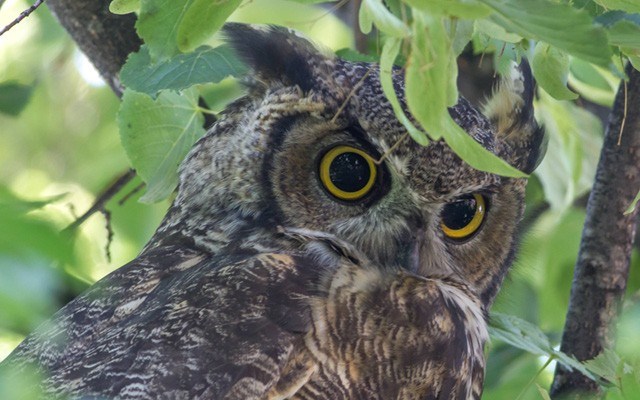A great horned owl, differential equations and climate change may not appear to have anything in common — but a new B.C. study points to a surprising link that could change the landscape of Canada's vast boreal forest.
Rebecca Tyson is an associate professor of mathematics at UBC's Okanagan campus, and a co-author of a published predator-prey study that has found a surprising connection between climate change and the possibility of species' extinction.
"What was unexpected was the extinction part," said Tyson, who used mathematical modelling on ecosystem data that features Canada's great horned owl and snowshoe hare.
Tyson explained there are two types of predators. Some predators are generalists, and eat numerous animals and vegetation to survive. And then there are the specialists that have one food source.
Tyson and her study partner Frithjof Lutscher, from the University of Ottawa, found that changes to summer patterns — particularly longer summers — have led to an adaptation of some species to actually switch from being a generalist in one season, to being a specialist in another season.
Tyson cites the example of the snowshoe hare, whose range is throughout the boreal forest, particularly in the mountains — including Whistler and the Sea to Sky corridor.
"There are some predators that are a specialist on the hare and the classic example is the Canada lynx. If the lynx can't get hare, it doesn't survive. The hare is the main component of the diet. Whereas other animals, such as coyotes, are more generalists. If the hares are in really low numbers, the generalists can supplement their diet with other things."
Another fan of the snowshoe hare is the great horned owl. But what Tyson and Lutscher found was that the great horned owl is a specialist predator on the hare in the winter, but then is a generalist on the hare in the summer, so the owl can survive on a wide variety of other prey in summer.
"Every other predator-prey model of the type that this is inspired from says that both can co-exist," said Tyson on the phone from her Kelowna office. "We found that with this model we actually get the predator driving the prey to extinction, which is quite unusual.
"So now we have the predator-prey relationship that's changing with the season, which means now you can ask: What happens when summer gets longer?" said Tyson.
"And that's what was different. Currently the great horned owl and the snowshoe hare and all the other animals are co-existing just fine, but summer is getting longer. And this is a new mechanism for extinction: the dynamic relationship between animals can change fundamentally as the climate warms."
Tyson explained that it's not unusual for the owl to look to other animals for a food source, but it is highly unusual that the owl switches from being a specialist to a generalist in different seasons.
"This behaviour in the great-horned owl was sort of an anomaly," said Tyson. "Very few other studies have documented this change."
The lynx is a specialist. Always will be. But Tyson said this forces the question of what happens when the lynx is added to the model.
"We would like to see what happens when you add other predators. Does that stabilize things, or not? Does it accelerate it?" Tyson asked.
During an extended summer, the owl could hunt hares to extinction, which, in turn, could imperil the lynx's sole food source.
The approach in the study involved two possibilities: taking the ecosystem data and trying to fit a model to it; or looking at behaviour and the mechanisms that produce such behaviour.
"So the model that was recently published is more on the mechanism and we wanted to ask what does that do to predictions for predator-prey communities if you have this behaviour?"
The study also points out that relatively small seasonal changes in summer season length can have a profound impact on the ecosystem — and dramatic effects on the predator-prey dynamics.
From here, the study recommends further investigation in multiple seasons and with varying behaviours, including those of human activities, snowfall, for example, and disturbances that can affect predator access to prey.
Tyson takes great pleasure in using mathematical biology.
"Just about any area of biology — you name it and there's a mathematician doing work in it. Equations tell you how things evolve over time."




